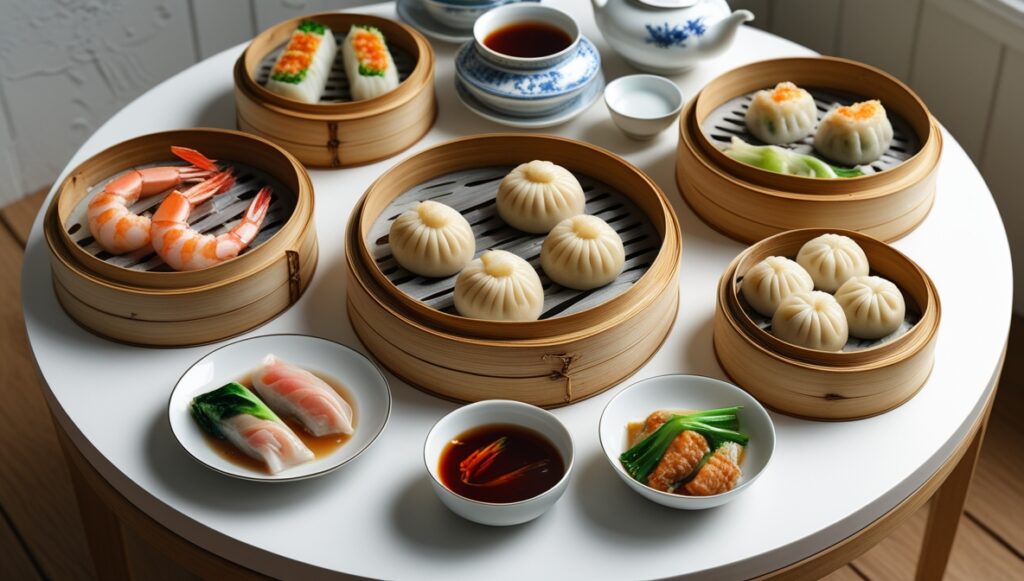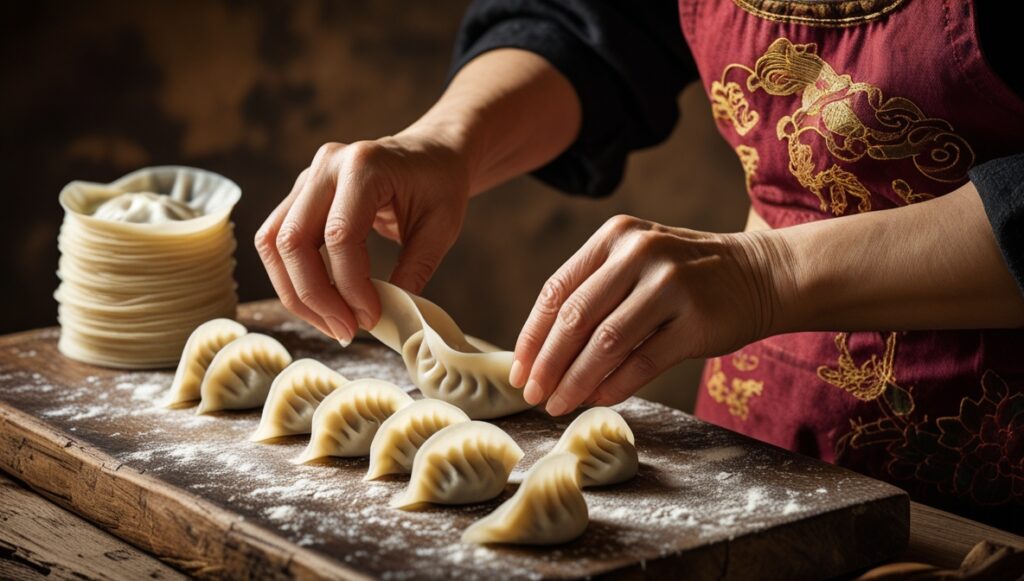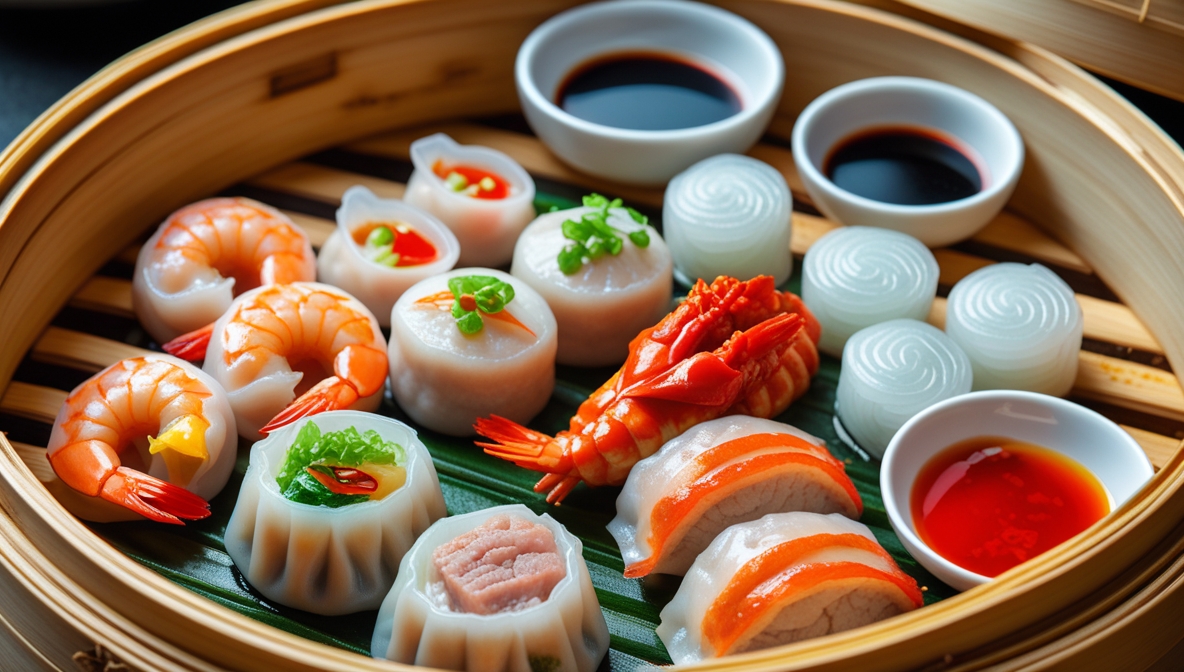Introduction
Dim Sum (點心), meaning “touch the heart,” is one of the most beloved traditions in Chinese cuisine. Rooted in southern China, especially Guangdong province, this array of small, handcrafted dishes offers a feast of textures and tastes. Served primarily during the morning to early afternoon, these bite-sized delights are often paired with tea in a practice known as Yum Cha, which blends flavorful food with social bonding.
More than a meal, Dim Sum is a communal experience. Friends and families gather at bustling teahouses to share plates, sip tea, and enjoy a leisurely morning or early afternoon. Whether steamed, fried, or baked, each item on the table contributes to a delightful mosaic of culinary artistry and culture.


History & Cultural Roots
The story of Dim Sum begins along the ancient Silk Road, where weary travelers would stop at teahouses for rest. Over time, these venues began serving small plates to accompany tea, thus birthing a practice that would become a cornerstone of Chinese cuisine.
By the 19th century, this tradition was thriving in Guangzhou, evolving into a cherished ritual known as Yum Cha. What began as a modest accompaniment to tea transformed into a gastronomic art form, reflecting both cultural pride and social connection. Today, the culture of sharing and tasting multiple small dishes remains central to family traditions and weekend routines across Chinese communities worldwide.
Common Ingredients & Regional Styles
Key Ingredients:
Proteins: Pork, shrimp, beef, and chicken
Vegetables: Chives, bamboo shoots, mushrooms
Wrappers: Thin sheets made from wheat or rice flour
Flavors: Soy sauce, sesame oil, ginger, garlic
Regional Variations:
Cantonese Style: The most recognized form, featuring delicacies like har gow (shrimp dumplings) and siu mai (pork dumplings)
Shanghai Style: Famous for xiaolongbao, the soup-filled dumplings
Sichuan Style: Adds a spicy kick with chili oil and Sichuan peppercorns
Modern chefs are also pushing boundaries by introducing fusion dishes that blend traditional Chinese elements with global trends, contributing to a growing list of Dim Sum Best Recipes found both in high-end restaurants and home kitchens.
Cooking Process & Difficulty Level

Skill Level: Intermediate to advanced
Basic Steps:
Prepare the Filling: Combine minced meat with vegetables and seasoning.
Make the Dough: Mix flour and water to form a smooth, pliable dough.
Assemble: Wrap the filling in dough and shape it according to the style.
Cook: Steam in bamboo baskets until perfectly done.
Pro Tips:
Use fresh ingredients for authentic flavor.
Learn folding techniques to shape dumplings uniformly.
Line the steamer with parchment or cabbage to prevent sticking.
For those seeking a culinary adventure at home, exploring Dim Sum Best Recipes is an excellent way to appreciate its intricacies and taste the results of your effort.
Where to Eat Dim Sum in China
If you’re wondering where to eat Dim Sum during your travels, here are some iconic spots:
Hong Kong:
Tim Ho Wan: The world’s most affordable Michelin-starred restaurant, perfect for traditional dishes.
Luk Yu Tea House: A cultural gem preserving the old-school ambiance and techniques of Yum Cha.
Guangzhou:
Panxi Restaurant: Set in a scenic garden with an expansive selection of small plates.
Shanghai:
Din Tai Fung: Known worldwide for its precision and delicious xiaolongbao.
Each location offers a unique take on the tradition, whether it’s classic simplicity or culinary innovation.
Pairings That Elevate the Meal
Drinks:
Tea: Jasmine, oolong, and pu-erh teas cleanse the palate between dishes.
Wine: Light-bodied whites like Riesling pair well with delicate dumplings.
Side Dishes:
Congee, stir-fried greens, and noodle dishes enhance the overall spread, offering balance and variety.
These pairings showcase how versatile this aspect of Chinese cuisine can be, adapting to both traditional and modern dining experiences.
Trivia & Interesting Facts
In traditional teahouses, dishes are served from steaming carts pushed between tables.
The pace is slow and communal—Dim Sum isn’t rushed; it’s savored.
Some teahouses allow patrons to check off their desired dishes on a menu slip—offering a more modern twist to Yum Cha.
This format allows for spontaneous choices and a bit of excitement each time a new dish arrives.
Health Benefits & Dietary Options
While many dishes are indulgent, steamed options offer a lighter, healthier alternative. Look for vegetable dumplings and rice noodle rolls for lower-calorie choices.
Health-Conscious Adaptations:
Vegan: Filled with mushrooms, tofu, or spinach
Gluten-Free: Opt for rice-based wrappers or fillings without soy sauce
Low-Carb: Choose meat-heavy fillings without starchy wrappers
By selecting carefully, this branch of Chinese cuisine can easily fit into a variety of dietary lifestyles.
Global Reach & Fusion Twists
Today, the influence of this culinary tradition stretches beyond China. International chefs are experimenting with unexpected mashups—Dim Sum tacos, sushi-style rolls, and even dessert dumplings.
The fusion of East and West demonstrates the adaptability of Dim Sum, and its increasing presence in global food culture only enhances its reputation as a crowd favorite.
Comparison with Similar Dishes
Dim Sum vs. Tapas (Spain)
Both Dim Sim and tapas are based on the idea of serving multiple small dishes meant for sharing, creating a communal and social dining experience. However, there are key differences:
Time of Day: Dim Sim is traditionally enjoyed during brunch or lunchtime, often as part of a Yum Cha tea session. Tapas are usually eaten in the evening, often with wine or beer.
Beverage Pairing: Dim Sum is typically paired with Chinese tea, while tapas are accompanied by alcoholic drinks like sangria, wine, or cerveza.
Flavors: Dim Sim features delicate, steamed, and savory bites often based on Chinese cuisine, whereas tapas range from boldly seasoned meats to marinated vegetables rooted in Spanish culinary traditions.
Dim Sum vs. Meze (Middle East & Mediterranean)
Meze is a selection of small dishes served as appetizers in countries like Lebanon, Turkey, and Greece. Here’s how they compare:
Meal Role: Both Dim Sim and Meze offer a variety of small portions, but Meze typically precedes the main course, while Dim Sum often constitutes the main meal itself.
Flavors & Ingredients: Dim Sim uses ingredients such as shrimp, pork, mushrooms, and rice flour wrappers, while Meze features hummus, olives, grilled meats, and yogurt-based dips.
Dining Style: Both emphasize social dining, though Meze is more likely to include cold and hot dishes served at once, whereas Dim Sum is served continuously, often from steaming carts.
Dim Sum vs. Bento (Japan)
Although not served for sharing, bento shares the compartmentalized variety seen in Dim Sim.
Presentation: Bento boxes are pre-packed individual meals, often designed for convenience and aesthetics. Dim Sum, on the other hand, is served fresh in small portions designed for group enjoyment.
Occasion: Bento is more about quick lunches, while Dim Sim is a leisurely brunch or weekend ritual.
Dim Sum vs. Korean Banchan
Banchan refers to the assortment of side dishes served with Korean meals.
Dish Variety: Like Dim Sim, Banchan includes many small dishes, but they are meant to accompany a main dish, not to be the focus of the meal.
Serving Style: Banchan is not individually ordered, whereas Dim Sim is typically selected à la carte from menus or carts.

